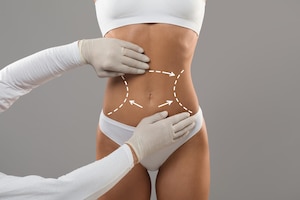A Comprehensive Guide to Body Contouring Surgery - What, Why and How?
 Body contouring surgery is the perfect way to get the body you’ve always wanted. Whether you have stubborn fat deposits that won’t go away, loose skin that you’d like to tighten, or simply want to improve the overall shape of your body, body contouring surgery can help you achieve your desired results. While body contouring surgery is becoming increasingly popular, many people are still unsure of what it entails and how it works. To help answer any questions you may have, this guide will provide a comprehensive overview of body contouring surgery, including what it is, why it’s done, and how it works. With this information, you’ll be better equipped to decide whether body contouring surgery is right for you.
Body contouring surgery is the perfect way to get the body you’ve always wanted. Whether you have stubborn fat deposits that won’t go away, loose skin that you’d like to tighten, or simply want to improve the overall shape of your body, body contouring surgery can help you achieve your desired results. While body contouring surgery is becoming increasingly popular, many people are still unsure of what it entails and how it works. To help answer any questions you may have, this guide will provide a comprehensive overview of body contouring surgery, including what it is, why it’s done, and how it works. With this information, you’ll be better equipped to decide whether body contouring surgery is right for you.
What is body contouring surgery?
Body contouring surgery, also known as cosmetic surgery, is a procedure performed to improve the shape and appearance of various parts of your body. Body contouring surgery is often done in tandem with other cosmetic procedures for the purposes of achieving a more balanced and proportional look overall. There are many types of body contouring surgery, including tummy tuck, liposuction, thigh lift, breast lift, and breast reduction.
Types of body contouring surgery
Tummy tuck – A tummy tuck procedure is an effective way to get rid of extra skin and fat deposits in your midsection. A tummy tuck is often used in tandem with liposuction to achieve an optimal outcome. Liposuction – Also known as liposculpture, liposuction uses controlled suction to remove unwanted fat deposits from a number of different areas of your body, such as your abdomen, thighs, hips, and buttocks. There are two types of liposuction: ultrasound-assisted liposuction (UAL) and traditional liposuction. ULA uses ultrasound waves to break up fat cells before suctioning them out, while traditional liposuction uses a combination of controlled suction and manual massage to remove fat. Buttock augmentation – Buttock augmentation procedures are commonly done in conjunction with liposuction to achieve a better overall aesthetic. There are two main types of buttock augmentation surgery: fat transfer and implant-based augmentation. Fat transfer – A fat transfer butt lift is performed by harvesting fat from one area of your body and transferring it to your buttocks. Fat transfer is the most common type of implant-free butt lift, but it is also the riskiest. Due to the unpredictable nature of fat transfer, results are often not consistent and sometimes lead to adverse outcomes, including infection, bad scarring, and abnormal swelling. Implant-based augmentation – Implant-based augmentation is a more traditional procedure that involves inserting an implant into your buttocks. Depending on the type of implant you choose, you will either have a smooth or textured buttocks. Unlike fat transfer, implant-based augmentation is generally safer and more predictable. Breast lift – Breast lift procedures are designed to lift sagging breasts, improve their shape, and reduce the size of the surrounding breast tissue. Breast lift procedures are also often done in conjunction with breast reduction surgery to remove excess breast tissue and tissue around the areola. Breast reduction – Breast reduction is a surgical procedure that is performed to reduce the size of your breasts and reshape them. Because overweight people are more susceptible to sagging and wrinkling of the skin, many people combine breast reduction with a tummy tuck procedure to achieve a slimmer and more toned look. You may also consider getting breast reduction if you have excessively large breasts and are self-conscious about their appearance.
Benefits of body contouring surgery
People choose to undergo body contouring surgery for a number of reasons, one of which is to improve their self-esteem. If you suffer from a condition like obesity, loose skin, or a deformity, it is more than likely that you are dealing with some level of body shame. While diet and exercise can help you lose fat and tighten loose skin, it is not a quick process and not everyone is able to achieve the results they desire. Body contouring surgery can help you get the body you’ve always wanted faster, with more predictable and consistent results. Aside from improving your confidence, body contouring surgery can also benefit your health. By removing excess fat, loose skin, and other undesirable attributes, you can improve the functionality of your organs, joints, and nerves. Getting rid of these unwanted areas can also help you avoid future complications and health problems, such as joint pain, skin sagging, and diabetes.
What results can I expect?
Many patients are curious to know how many pounds they can lose with a given procedure. The amount of fat you can lose will vary based on your individual needs. That being said, you should be aware that body contouring procedures are not meant to be a replacement for sound nutrition and exercise. You should be aware that the results of these procedures will be significant but not complete transformations. Many patients who undergo these procedures are able to achieve significant weight loss, improved skin, and better overall health.
What should I consider before getting body contouring surgery?
While many people consider body contouring surgery to be a quick and easy fix for their weight loss goals, it is important to remember that surgery is not without its risks. Before scheduling a consultation with a cosmetic surgeon, make sure that you have an honest conversation with yourself about your expectations and motivations. It is also important to be mindful of the fact that body contouring surgery is not a quick fix. While it can help you achieve a slimmer physique, you need to follow a healthy diet and get regular exercise to maintain your results. Another thing to keep in mind is that the results of body contouring surgery are not permanent. Fat cells are known to regenerate, meaning that if you return to your old eating habits, you may experience a significant weight gain. To avoid this, make sure that your nutrition and exercise routines are as healthy as possible.
What are the risks?
As with any surgical procedure, there are certain risks involved with body contouring surgery. These risks include infection, bleeding, blood clots, and allergic reaction to the anesthesia. Your surgeon will be able to discuss these risks with you and let you know if they are significant enough to warrant changing your decision to go through with the procedure.
How to prepare for body contouring surgery
Body contouring surgery is a major procedure, so it is important to prepare yourself both mentally and physically. Make sure that you are prepared to take time off work and have someone to help you with daily activities during your recovery period. While it is impossible to predict how your recovery will go, there are a few things you can do to prepare yourself for surgery. One thing you should do is make sure you have a healthy diet. Your body will need plenty of nutrients and energy to heal properly, so make sure you are eating plenty of fruits, vegetables, and whole grains. It is also important to get plenty of sleep, avoid stress, and maintain an exercise routine. It is best practice to stop exercising at least two weeks before your surgery so that your body can heal properly. If your surgeon recommends it, you may also want to consider taking a painkiller before your surgery.
Recovery tips
– Make sure you take it easy. While you may be eager to get back to your daily activities after surgery, it is important to pace yourself. Schedule some rest days, and try to avoid strenuous activities to allow your body to heal properly. – Follow your surgeon’s instructions. Make sure to follow all of your surgeon’s instructions during recovery. This will help reduce your risk of complications, and you will recover faster. – Embrace your new body. During your recovery, it is easy to compare your post-surgery body to your pre-surgery body. The most important thing to remember is that your surgery is not a competition. Rather, it is a journey that is meant to help you achieve your desired results.
Conclusion
Body contouring surgery is a safe and effective way to improve the shape and appearance of your body. While it is important to remember that these procedures are not meant to be a replacement for sound nutrition and exercise, they can help you achieve a slimmer physique faster with more consistent and predictable results. To prepare for your surgery, it is important to make sure that you have a healthy diet, get plenty of rest, and follow your surgeon’s instructions. During your recovery period, it is important to pace yourself, embrace your new body, and follow
